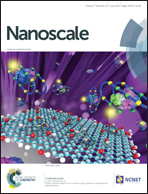Trace detection of tetrabromobisphenol A by SERS with DMAP-modified magnetic gold nanoclusters†
Abstract
Magnetic gold nanoclusters (MGNCs) functionalized with 4-dimethylaminopyridine (DMAP) enables the trace detection of tetrabromobisphenol A (TBBPA), an environmental pollutant, using surface-enhanced Raman scattering (SERS) spectroscopy. The synthesis, cleansing, and functionalization of MGNCs are conducted in aqueous solutions; SERS samples are prepared by magnetic precipitation in the presence of trace analyte. The limit of detection (LOD) for TBBPA is greatly increased by the use of DMAP as a reporter molecule: DMAP-modified MGNCs can detect TBBPA at 10 pM in water, whereas the LOD for TBBPA by unfunctionalized Au is 1 nM. The reproducibility of picomolar TBBPA detection with DMAP-modified MGNCs is confirmed by two-dimensional correlation analysis. The high SERS sensitivity for TBBPA can be attributed to its capacity to modulate the Raman spectrum of adsorbed DMAP. This indirect mode of detection can also be applied toward the detection of other hydrophobic analytes, each identifiable by its characteristic SERS identity.


 Please wait while we load your content...
Please wait while we load your content...